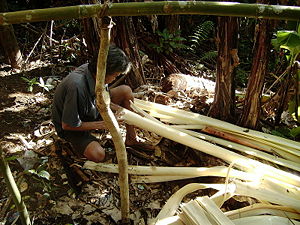Abaca
 From Conservapedia
From Conservapedia 
The Abaca (Musa textilis) is a plant related to the banana plant, though the fruit from the abaca is not edible. Its fiber is referred to as Manila hemp, though it is not actually hemp.[1] The abaca plant is native to the Philippines.[2] Manilla envelopes and manilla folders take their name from this particular fiber.[1]
Biology[edit]
The Abaca plant is a member of the Musacae family.[3] It is well distributed in the tropical humid regions, and consists of stalks 2 inches in diameter with oblong, pointed leaves and an herbaceous trunk.[3] This trunk is sliced into thin strips in order to convert the plant into rope or paper.[4]
Usage[edit]
The plant was important as a source of cordage fiber (especially for the riggings of ships in the 1800s,[5] and in 1915, the Dutch expanded cultivation from the Philippines to Sumatra in Indonesia while the United States Department of Agriculture introduced it to Central America. Despite this, the Philippines remain the primary producer of abaca, followed by Ecuador and Costa Rica.[6]
References[edit]
- ↑ 1.0 1.1 Philippine Herbal Medicine
- ↑ Nuttall Encyclopedia of General Knowledge, article on Abaca originally published in 1907 written by Reverend James Wood
- ↑ 3.0 3.1 "Abaca". The New Encyclopedia Britannica. 15th ed., Vol. 1
- ↑ http://www.naturalfibres2009.org/en/fibres/abaca.html
- ↑ http://www.fao.org/economic/futurefibres/fibres/abaca0/en/
- ↑ https://textilefashionstudy.com/top-abaca-producers-country-of-the-world-hard-fiber-production/
Categories: [Plants] [Philippines]
↧ Download as ZWI file | Last modified: 02/14/2023 03:21:23 | 61 views
☰ Source: https://www.conservapedia.com/Abaca | License: CC BY-SA 3.0
 ZWI signed:
ZWI signed: KSF
KSF